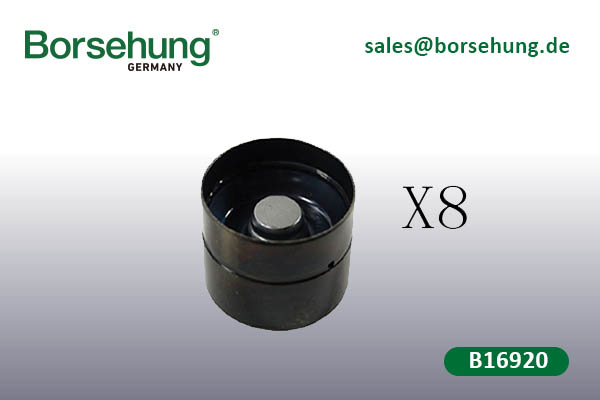Working principle of air valve hydraulic tappet:
During operation of an engine, when the air valve is closed, the engine oil flows into the plunger piston cavity via the oil hole on the side of the tappet and the narrow passage in the piston. It pushes away the check valve and directly enters the tappet body cavity (a high-pressure chamber). The piston then rises under the oil pressure of the tappet body cavity and the effect of the spring, pressing the air valve push rod tightly. At this point, the uplift force of the piston is not sufficient to overcome the tensile force generated by the air valve spring. The air valve is therefore not opened. Instead, the gap in the whole air valve mechanism is eliminated. After the tappet body cavity is filled up with oil, under the oil pressure and the effect of the spring, the check valve will cut off the oil flow.
When the cam rotates to the working face, the tappet will rise, and the tensile force generated by the air valve acts on the plunger piston via the air valve push rod. However, since the check valve is already closed and consequently prevents the oil from spilling, the non-compressibility of the oil causes the tappet as a whole to push the air valve open. In this process, due to the high pressure of oil in the tappet body cavity, a small amount of oil will leak out via the gap between the tappet body and the piston, thereby shortening the working length of the tappet. After the cam rotates past the working face, the tappet will drop, and the air valve will be closed, resulting in a decrease of the oil pressure in the tappet cavity. Consequently, the oil in the main oil circuit will again push away the check valve and flow into the tappet body cavity to replenish the oil there and start another cycle.
Through oil leakage and replenishment of the oil in the tappet body cavity, the working length of the tappet is adjusted automatically, thus ensuring normal operation of the air valve and eliminating gap in the whole mechanism. The benefits include reduced shock and noise between components and elimination of the air gap that exists in old engine air valve models. In addition, by using a hydraulic tappet, a steeper camshaft profile can be adopted to achieve faster opening/closing of the air valve, which is more suited to the needs of modern high-RPM engines.

Name: hydraulic tappet repair kit/8 per kit
Ref No. : 038109309C
Replacement code: 038109309A/038109309B
Applicable models:
Skoda: FAB 00-10/FABI 09-14/OCT 01-13/RO 06-10/SUP 02-13
VW: BE 99-10/BEC 03-10/BO 03-05/CA 04-11/CAMP 04-10/EOS 06-08/FO 05-12/GOLF 03-09/GOPL 05-09/IMD 90-08/JE 06-11/LU 99-06/PA 01-11/PHAE 02-07/PO 02-10/POS 04-06/SHA 96-10/TOU 03-10/TOUA 03-10/TR 03-10
Seat: AL 01-10/ALT 04-13/AR 97-04/CO 03-09/IB 02-11/LE 00-13/TO 99-09
Audi: A2 00-05/A3 04-13/A3CA 08-13/A4 99-08/A4Q 99-08/A6 98-05/A6Q 02-05/AA4C 07-09

